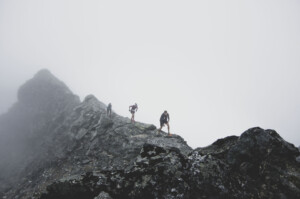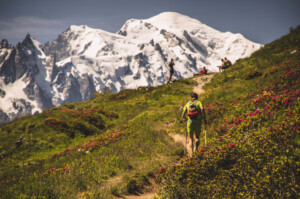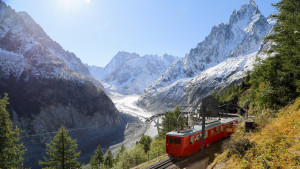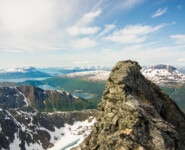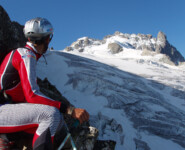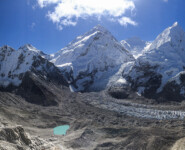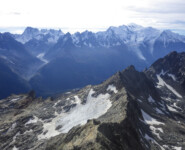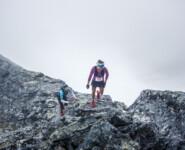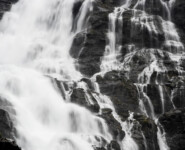The Kilian Jornet Foundation not only bears the most illustrious name in trailrunning – Kilian Jornet – but is also one of the most prominent voices when it comes to bringing sustainability to the mountains and trails. One of its central tools is the Green Trail concept. A collaboration with the legendary Zegama-Aizkorri race shall take it t from the concept phase to practical application. We discussed what this means exactly.
“A milestone for sustainable trailrunning” – that’s how the collaboration is confidently being called. We wanted to know more about this milestone and sat down with Laura Viñals Rotellar, project manager and communications manager at the Kilian Jornet Foundation, and learned many details about the concept, the collaboration and the potential significance for sustainability in trailrunning.
Laura, before we get to the main topic we want to discuss today – how has the year been for you so far, working at the intersection of sustainability and trailrunning?
Laura: It was really good so far – and quite busy with lots of projects. The other day, for example, we were with some colleagues in La Cerdanya, where our team often meets and where Killian was born and raised. I’ve seen a lot of changes in that area. It’s striking to notice how these mountains used to be snow-covered in winter, but now they aren’t. Then suddenly, in March, it snows like crazy. It’s shocking to witness these changes within just one lifetime. When you step outside, you can see them clearly, which is why we do what we do. The changes are undeniable.
If people are shocked, maybe they’ll wake up and realize something needs to be done…?
Laura: Perhaps, but it’s complicated because people often don’t know how to address these changes. That’s why we’re trying to bridge that gap. We collect knowledge from scientific projects and other initiatives, then translate that into actionable insights for communities and society at large.
One example for this approach is your cooperation with the Zegama-Aizkorri race. What exactly does the cooperation entail? People might have heard about the Green Trail concept and, of course, know the race, but what does this collaboration mean in concrete terms?
Laura: The Green Trail concept is a European project planned over three years. The main goal is to create a certification scheme for trailrunning races, helping them transition to a more sustainable model. This certification is based on an online platform where race organizers can input various indicators to assess sustainability – not just in environmental terms but also from social and economic perspectives.
We’re now in the final phase of the project. For almost a year and a half, we’ve been working with Zegama on refining the indicators. They have already done a lot for environmental sustainability and community engagement within their race and town. Zegama provides the perfect case study: it’s a significant race with a strong community impact but without a major corporate structure behind it. This marks it an ideal testing ground for making the certification as accessible and widely applicable as possible.
We have finalized 67 indicators across social, environmental, and economic categories. Zegama has already gone through the self-assessment phase, answering all the required questions. Now, we will test how the tool performs on site with real-time data. Afterward, we’ll analyze the post-race impact to fine-tune the certification model.
Beyond this, the collaboration serves to inspire and engage other race organizers. We want to show that this tool isn’t about auditing or penalizing races but about guiding them toward sustainability. Many races are already doing great things but don’t categorize them as sustainability efforts. This tool helps race organizers recognize and build upon what they’re already doing well while identifying areas for improvement.
If I understand correctly, the project has three phases: First, setting up the framework and defining the indicators. Second, testing them in a real life scenario. Third, scaling up, using Zegama as a case study to show others that it’s feasible and beneficial.
Laura: Exactly! By December, the project will be wrapped up, and in January 2026, the tool will be available for everyone. At that point, we can confidently say: “Here’s a tool backed by thorough research and real-world testing, including insights from Zegama.”
Has Zegama already done something in regards to sustainability that positively surprised you? Way too often, the pursuit of sustainability stops at not providing plastic cups or perhaps offering a discount on public transport. Which is not enough if you are serious about sustainability.
Laura: What surprised us was how much they were already doing without labeling it as “sustainability”. For example, they had strong social initiatives in place but didn’t explicitly recognize them as part of a sustainability framework. By going through the indicators with them, we helped categorize and structure their existing efforts. This is a common observation – we often find that organizers are doing great things but don’t systematically assess their impact. The certification will help monitor and track improvements year by year, making it easier to set new goals.
If other race organizers are interested to apply the Green Trail tool, will they need your guidance to complete the certification process, or can they manage it independently?
Laura: There will be two options. Since this is a European project, we will make a self-assessment version freely available for two to three years, allowing any race to evaluate itself. We will also offer a certified version, where our team provides auditing and validation. The goal is to keep it as accessible as possible while ensuring credibility. Race organizers who complete the assessment will also receive tailored recommendations on how to improve.
A potential concern for organizers will be resources – both financial and time-related. Even if participation is free, it still takes time. How demanding will the process be?
Laura: That’s a key question. Many sustainability certifications require enormous time investments. Our goal is to avoid that. The process should be as streamlined as possible while still delivering value. Race organizers need to see the benefit. We’re also working with major players in the trailrunning world to elevate the importance of sustainable races. While there will be some cost for the audited version, we’re designing it to minimize the burden on organizers.
When thinking about potential early adopters, I see three groups: small non-profit races, large commercial races, and sustainability-focused races like EcoTrail. Which group do you see as the first movers?
Laura: All of them are important, but our real aim is to engage races that aren’t already focused on sustainability. Trailrunning is incredibly diverse. The challenge therefore is to make the tool relevant across all these variations. That’s why we’re also exploring partnerships with groups like Natura 2000, which work on standardizing environmental regulations. This way, we can ensure the tool applies across different countries and contexts.
Let’s address the elephant in the room: Can large-scale races be truly sustainable? Events like Ultra-Trail du Mont-Blanc (UTMB) bring thousands of people to small towns, requiring massive infrastructure and resources. Can they realistically meet sustainability standards, or do we have to accept that they never will?
Laura: That’s the big question. The challenge isn’t just the number of runners – it’s also the audience size, the media presence, and the overall footprint. But these races also bring economic and social benefits to local communities, which can’t be ignored. Some towns thrive because of these events. The key is to rethink how they’re organized – limiting environmental impact while maximizing positive social and economic effects. There’s no simple yes or no answer, but we believe sustainability is possible if approached thoughtfully. That’s exactly what the Kilian Jornet Foundation aims to achieve.

